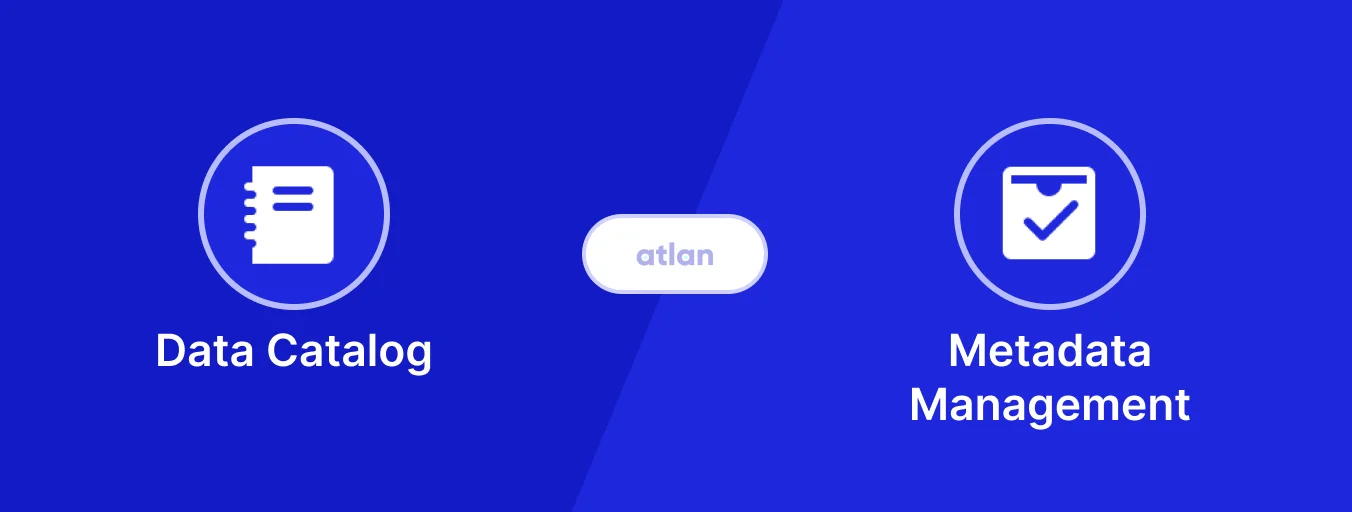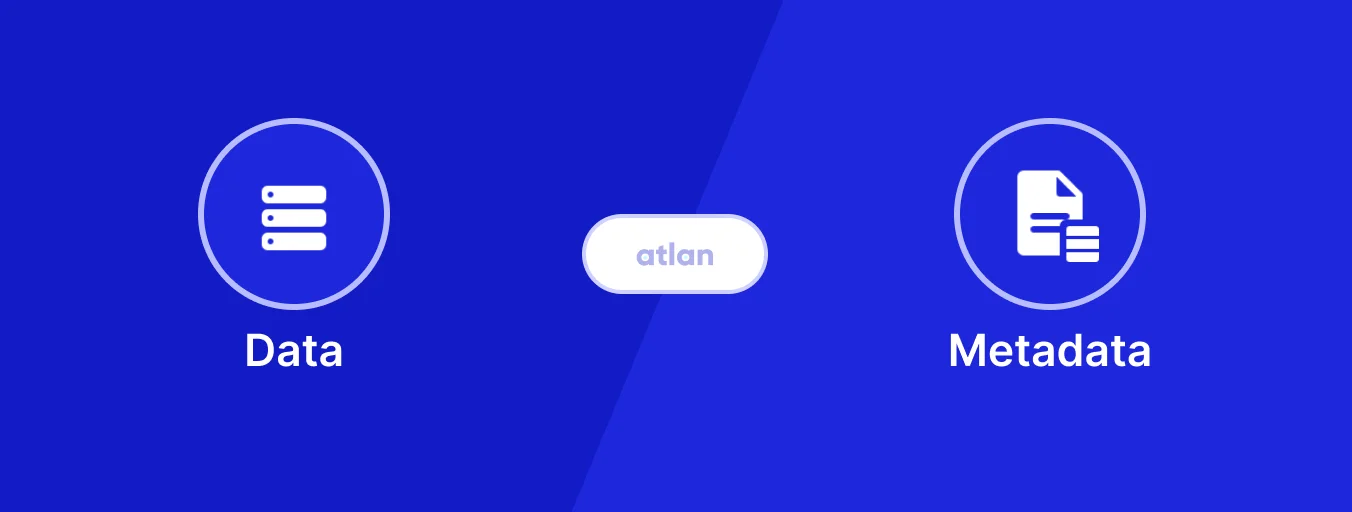6 Types of Metadata: Overview, Examples, and Applications
Share this article
The six main types of metadata are technical, governance, operational, collaboration, quality, and usage metadata. These describe file properties, data policies, workflow logs, collaboration details, data quality, and usage patterns, respectively.
See How Atlan Streamlines Metadata Management – Start Tour
Types of Metadata #
The six main types of metadata include:
- Technical metadata: Describes file properties and system details, such as file format, creation date, and size.
- Governance metadata: Encompasses information on data policies, access permissions, and compliance standards.
- Operational metadata: Contains data related to processing and system operations, like workflow logs and processing history.
- Collaboration metadata: Includes information on how data is shared or collaboratively modified.
- Quality metadata: Captures data accuracy, completeness, and quality measures.
- Usage metadata: Reflects how and when data is accessed or utilized by users.
Metadata is the “what, where, when, how, and who” of data.
According to Gartner, metadata is information that describes various facets of an information asset to improve its usability throughout its life cycle. It unlocks the value of data by helping to answer the “what, where, when, how, and who” of data.
There are several types of metadata. For instance, NISO (National Information Standards Organization) classifies metadata as descriptive, administrative, structural, and markup languages. The author of The Data Warehouse Toolkit Ralph Kimball identifies three types of metadata — descriptive, structural, and administrative.
The types of metadata represent its use cases. That is why we will focus on six types of metadata that translate into essential use cases for modern data organizations.
Are you curious about how to effectively use metadata for various use cases? We’ve gathered the best insights from our team. Check it out here.
Table of contents #
- Types of metadata
- 1. Technical metadata
- 2. Governance metadata
- 3. Operational metadata
- 4. Collaboration metadata
- 5. Quality metadata
- 6. Usage metadata
- Summing up on types of metadata
- FAQs on Types of Metadata
Types of metadata #
These are the six main types of metadata:
- Technical metadata
- Governance metadata
- Operational metadata
- Collaboration metadata
- Quality metadata
- Usage metadata
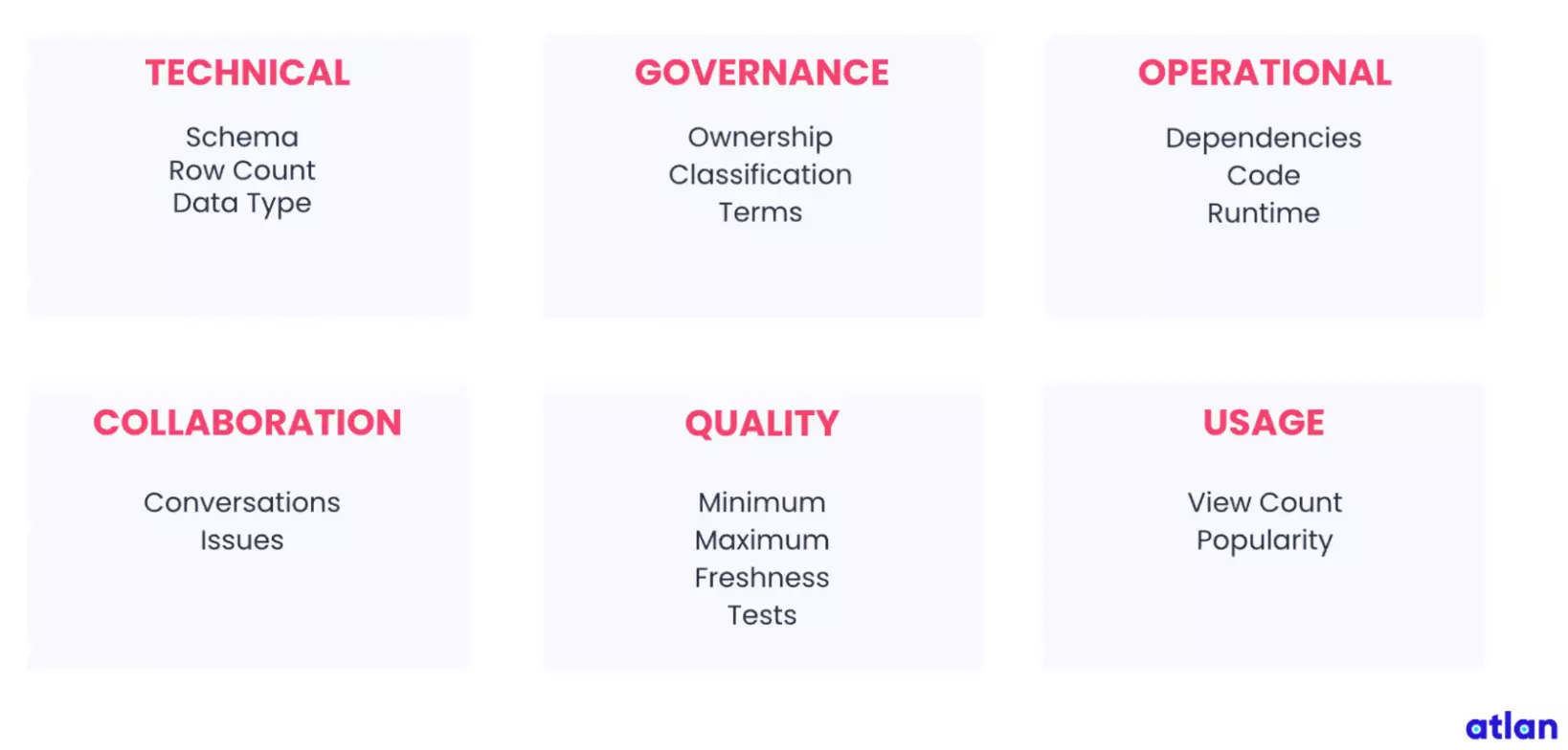
The six types of metadata: are technical, governance, operational, collaboration, quality, and usage. Source: Atlan.
1. Technical metadata #
According to the University of Warwick,
Technical metadata provides information on the technical properties of a digital file or the particular hardware and software environments required in order to render or process digital information.
So, technical metadata can include information about the rules, structure, and format for storing data, such as the location, data source, row or column count, data type, and schema.
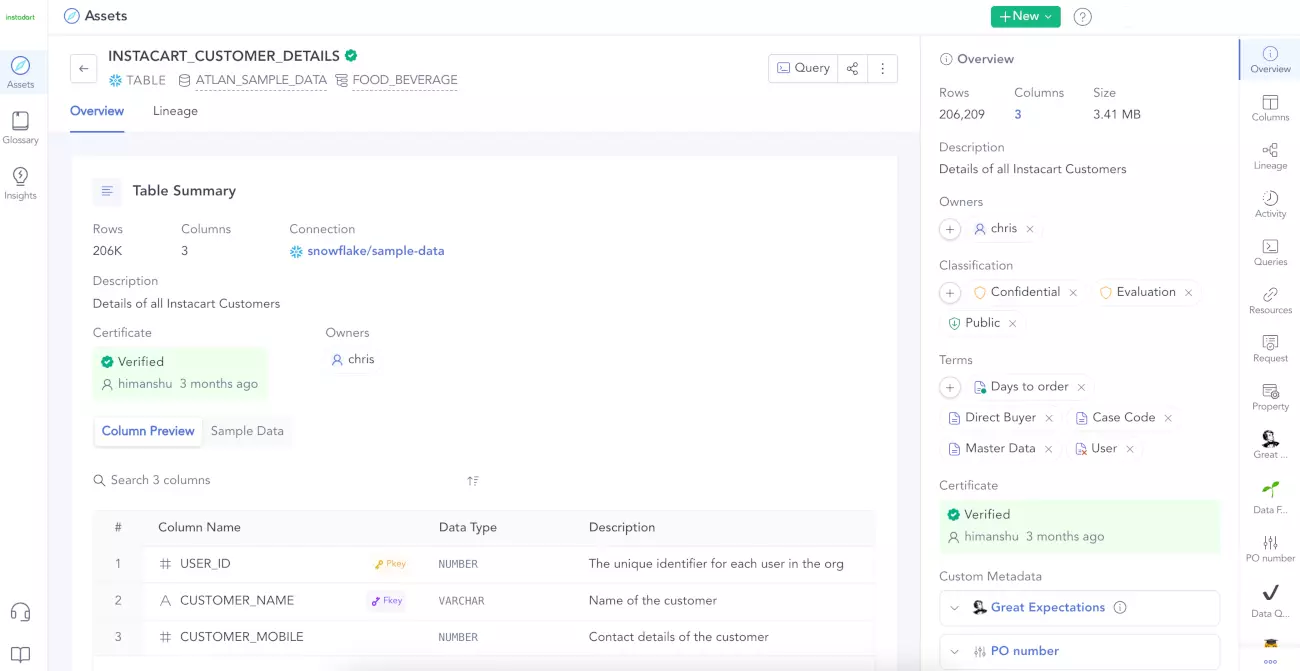
An example of technical metadata. Screenshot from Atlan’s active metadata platform. Source: Atlan.
For data to be discoverable and useful, it must have a logical structure and properties such as data type, name, size, owner, etc. Schemas, an example of technical metadata, store this information.
2. Governance metadata #
Governance metadata provides information on how data is created, stored, accessed and used. So, it includes governance terms, data classification, ownership information, etc. With governance metadata, you can control how your data can be used, who can access them, and for what purpose.
For instance, you can set up user restrictions for PII data stored in Snowflake and define who can access what, and how the data can be used. This helps you ensure the security and credibility of data while guaranteeing regulatory compliance.
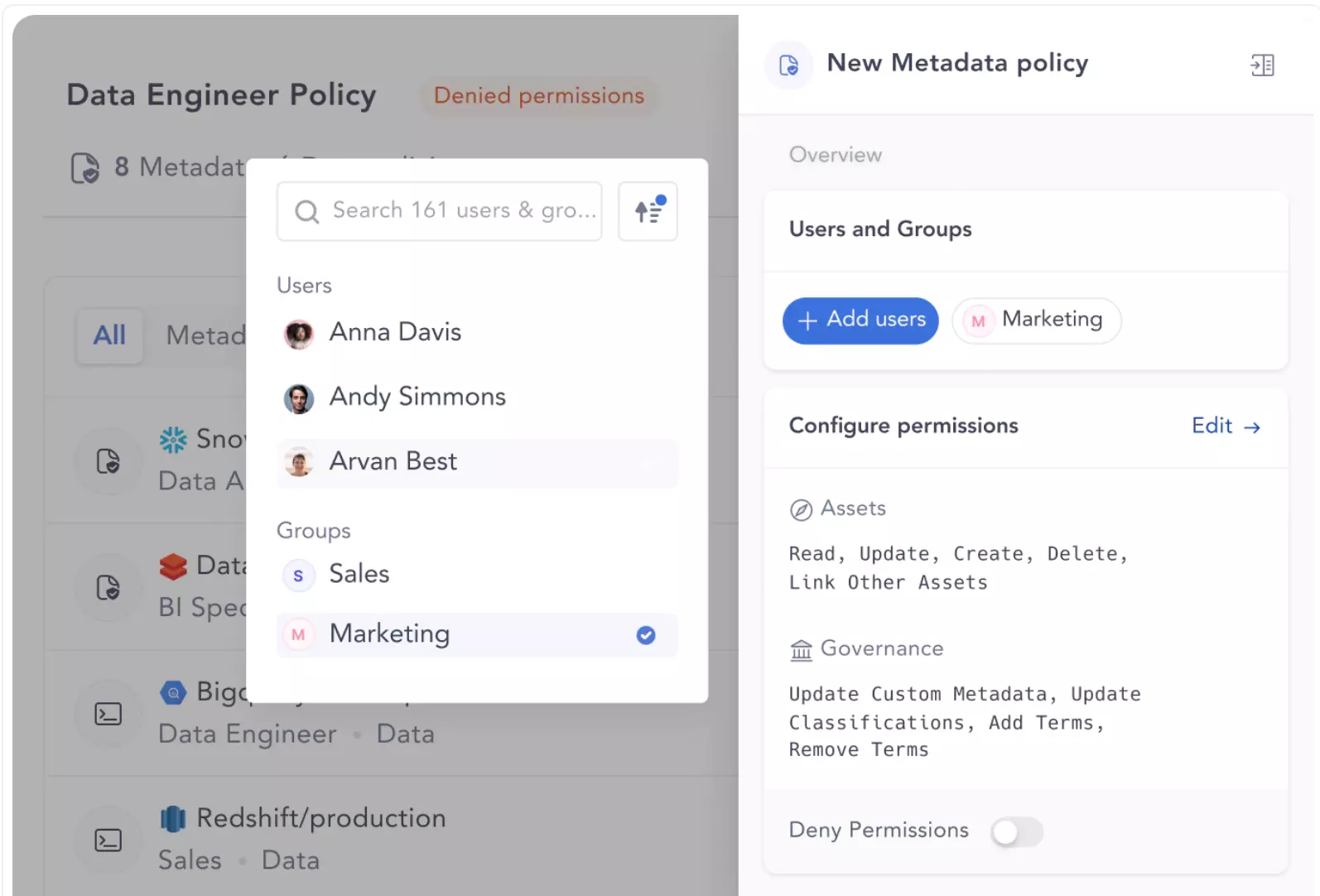
Governance metadata in action. Screenshot from Atlan’s active metadata platform. Source: Atlan.
3. Operational metadata #
According to IBM,
Operational metadata describes the events and processes that occur and the objects that are affected.
So, operational metadata tracks everything related to the flow of data throughout its lifecycle. So, it can include information on the flow of data such as dependencies, code, lineage, ETL logs, and runtime. It adds an extra level of detail to data repositories and ETL processes.
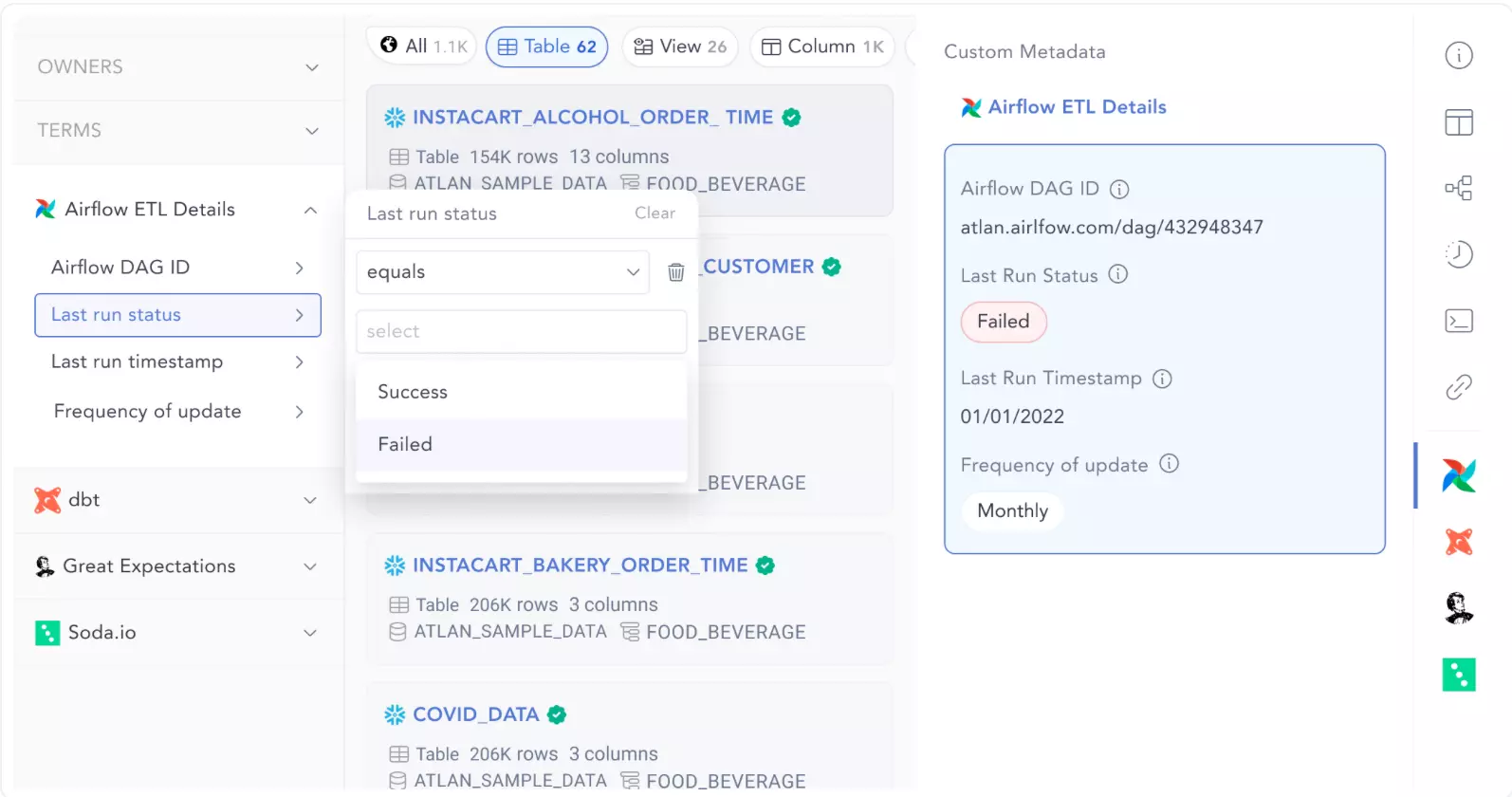
Operational metadata in action. Screenshot from Atlan’s active metadata platform. Source: Atlan.
Data provides value only if you can trust it. For that to happen, you should be able to have end-to-end visibility on everything from how data was ingested to the various forms in which it was used. That’s where operational metadata can help.
4. Collaboration metadata #
Collaboration metadata is social metadata that contains insights on conversations around data. This includes data-related comments, discussions, chat transcripts, tags, bookmarks, and issue tickets.
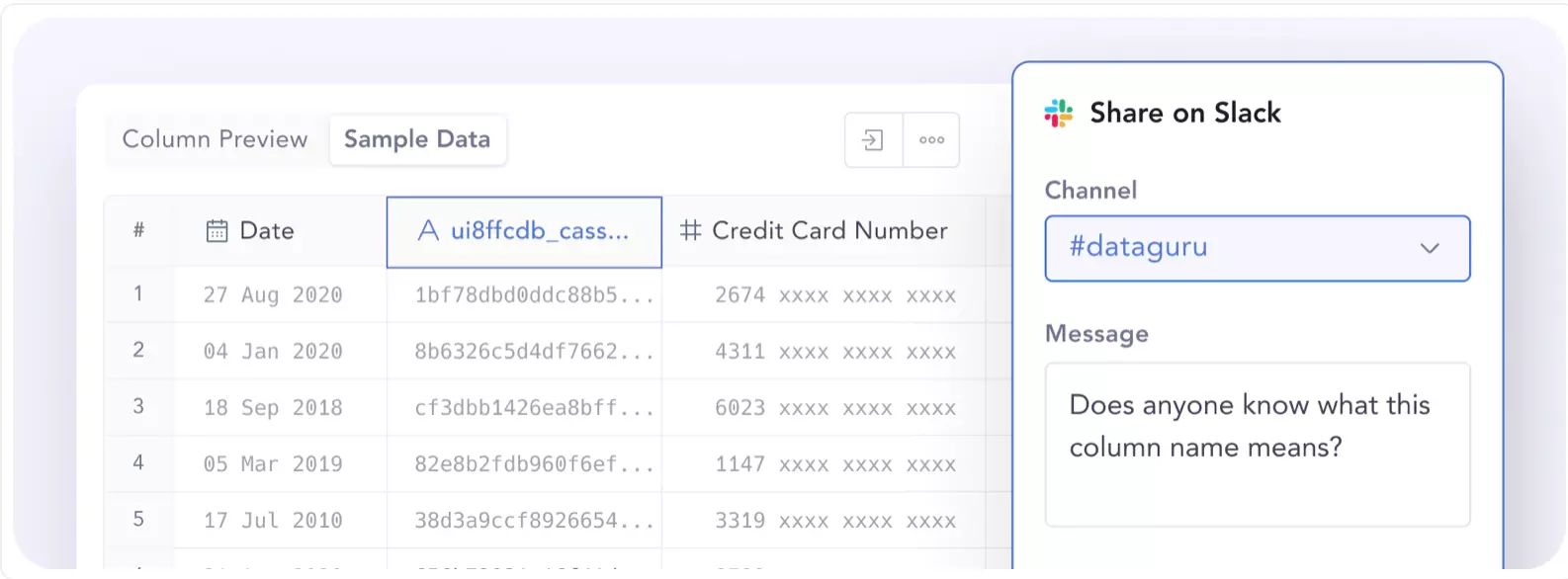
An example of collaboration metadata. Screenshot from Atlan’s active metadata platform. Source: Atlan.
For instance, understanding an unknown column within a table in the regional customer’s report could be an issue that several people have raised via Slack chats. Collaboration metadata would help chronicle such information so that your data team can update the column within the report and notify everyone who reported the issue.
5. Quality metadata #
According to an exploratory study on data quality metadata for decision-making,
Quality metadata is ”information about the quality level of stored data in organization databases, and is measured along different dimensions such as accuracy, currency, and completeness.”
So, Quality metadata can include quality metrics and measures, such as dataset status, freshness, tests run, and their statuses.
For instance, if you’re studying multiple tables on customer order-related data, you can look at quality metadata such as last test status, runtime, and percentage of test success to determine whether the data is credible.
Modern data catalogs also attribute a certificate of verification to tables, making it easier for data consumers to pick the right data and rely on it for decision-making.
6. Usage metadata #
Usage metadata records information about how much a dataset is used. So, it can include an asset’s view count, popularity, top users, frequency of use, and more. Usage metadata can be used to understand how an asset gets consumed, look for access patterns, and get rid of data that isn’t used much but is taking up warehouse space.
For instance, you can look at access patterns — how many times was that asset accessed, when, and by whom — to gauge whether a certain asset is popular. Let’s assume that two members of your marketing team have run several queries for the table containing customer information.
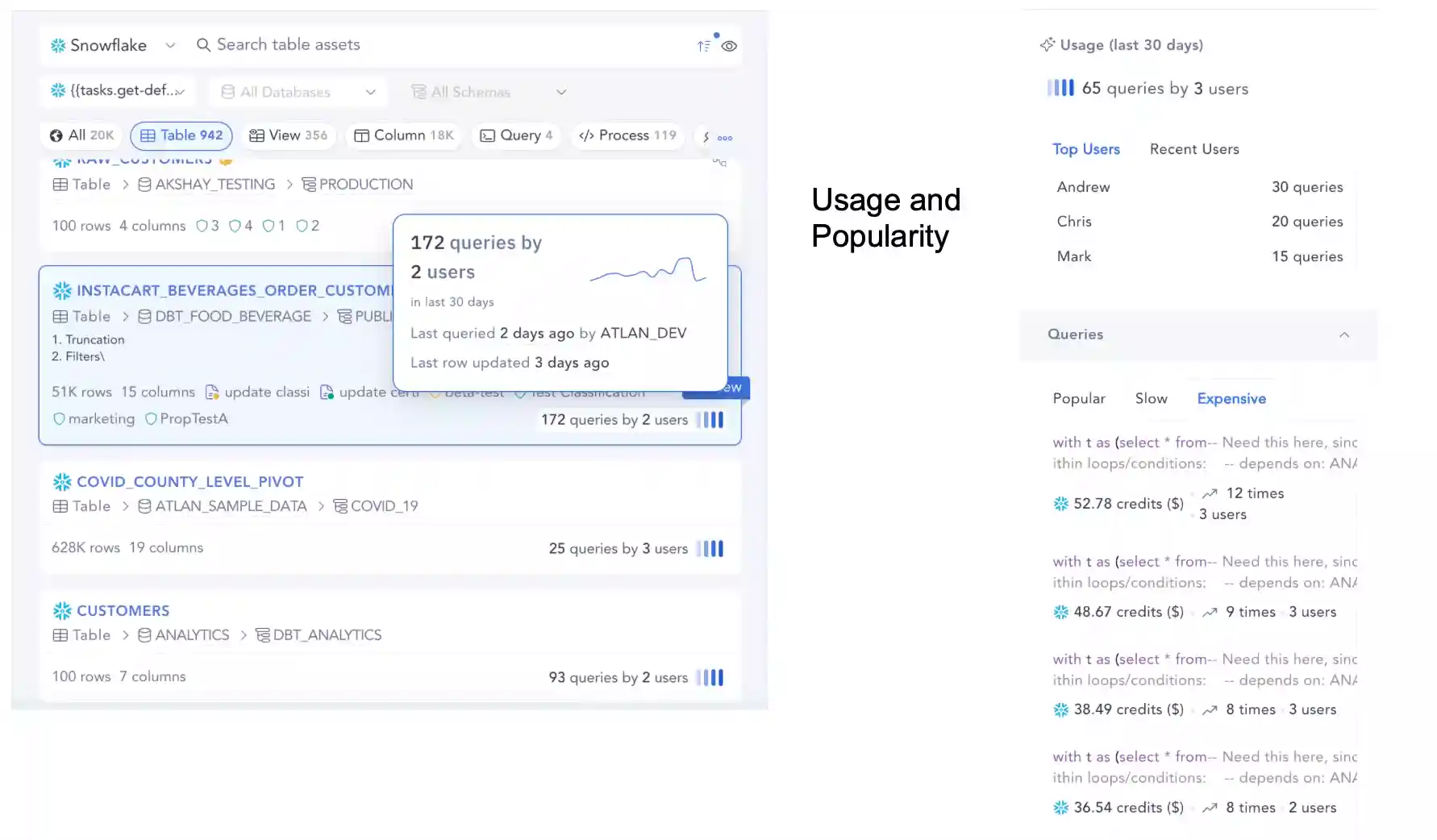
What usage metadata for an asset could look like. Screenshot from Atlan’s active metadata platform. Source: Atlan.
After studying usage metadata, you realize that your marketing team analyzes this table at the beginning of each quarter. You can work on making the data more accessible and comprehensive for the marketing team, and get their input to optimize it further. This promotes greater efficiency, productivity, and cost savings.
While managing metadata, you can think of the different types of metadata listed above as active or passive metadata.
Types of metadata management: #
- Active metadata
- passive metadata
Passive metadata is the metadata collected and managed via manual processes. It is static and requires human effort to curate and document. As a result, it doesn’t offer complete visibility into what’s happening inside data pipelines in real time.
Meanwhile, active metadata is data that defines data, and everything that happens or is done to it. Unlike passive metadata, active metadata is captured from sources in real-time, so data practitioners and business leaders can easily identify, track, manage, trust, and understand data assets.
Read more on -> Active metadata
Summing up on types of metadata #
Understanding the various types of metadata that exist within your organization is the first step to documenting its use cases and setting up an ecosystem that leverages them.
After documenting the types of metadata, the next step is to ensure effective handling with an active metadata management platform like Atlan.
Atlan is built for the modern data stack, clearly shifting from the traditional metadata management to the new era of: “Collaboration-focused, intelligent, and open by default”.
Atlan empowers organizations to establish and scale data governance programs by automating metadata management, providing end-to-end lineage tracking, enabling collaboration across diverse personas, and offering an extensible platform for customized governance workflows and integrations.
Atlan’s approach ensures data quality, security, and compliance while fostering data literacy and self-service across the organization.
Tide’s Story of GDPR Compliance: Embedding Privacy into Automated Processes #
- Tide, a UK-based digital bank with nearly 500,000 small business customers, sought to improve their compliance with GDPR’s Right to Erasure, commonly known as the “Right to be forgotten”.
- After adopting Atlan as their metadata platform, Tide’s data and legal teams collaborated to define personally identifiable information in order to propagate those definitions and tags across their data estate.
- Tide used Atlan Playbooks (rule-based bulk automations) to automatically identify, tag, and secure personal data, turning a 50-day manual process into mere hours of work.
Book your personalized demo today to find out how Atlan can help your organization in establishing and scaling data governance programs.
FAQs on Types of Metadata #
Q: What are the primary types of metadata? #
A: The primary types of metadata are Technical, Governance, Operational, Collaboration, Quality, and Usage metadata. Each type serves different functions to enhance the organization, management, and usability of data assets.
Q: What is Technical Metadata? #
A: Technical metadata provides information about the technical aspects of data, such as file types, database structure, or format. This metadata is essential for understanding the foundational setup of data assets and ensuring they are compatible with different systems.
Q: How is Governance Metadata used? #
A: Governance metadata ensures that data complies with internal and external policies and regulations. It includes information about data ownership, access permissions, and regulatory compliance, helping maintain data accountability and security.
Q: What role does Operational Metadata play? #
A: Operational metadata details data processing activities, including data lineage, workflows, and data movement across systems. It helps track the processes applied to data, aiding in troubleshooting and optimization.
Q: What is Collaboration Metadata? #
A: Collaboration metadata captures information related to the interactions and communications around data assets. This includes comments, annotations, and shared notes that help teams collaborate effectively on data projects.
Q: How does Quality Metadata contribute to data management? #
A: Quality metadata provides insights into data accuracy, completeness, reliability, and validity. It includes quality scores or validation rules that ensure data meets organizational standards and is fit for use.
Q: What is Usage Metadata, and why is it important? #
A: Usage metadata tracks how data is used, including user interactions, access frequency, and usage trends. This type of metadata helps identify valuable data assets, optimize data storage, and enhance data accessibility.
Share this article










